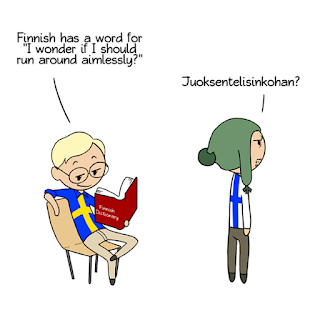 | ||
| Source: http://satwcomic.com/aimlessly |
PYÖRÄILisinköhän. The base of the word is the verb "pyöräillä", to ride a bike. The original meme about running is a bit different than riding a bike, because for riding a bike the basic form of the verb is the same as its frequentative form, where as for running to run is "juosta" and the frequentative to run around aimlessly is "juoksennella". Frequentative form implies repetition but also that the activity is less focused and not goal oriented. For cycling, the word is the same whether or not the activity is focused and regardless of how many times you repeat it. This observation could be a beginning for a study in the Finnish philosophy of cycling, but I'll leave that for later. In this blog I'm usually riding around aimlessly and I try to repeat it as often as I can.
pyöräilisiNköhän. "Pyöräillä" is the base form for riding a bike which does not specify who is riding. We don't need a separate word for that but can do it by little adjustment and addition. I'm riding a bike is "pyöräileN", you're riding a bike is "pyöräileT", he/she/it is riding a bike "pyöräileE". So in this blog it's me who is riding a bike.
pyöräilISInKÖhän. -ISI- and -KÖ- are two different but connected additions. Finnish language has seven so called clitic endings or "liitepartikkelit" as we call them in Finnish. In this case -KÖ- transforms the word into a question. And when the word is transformed into a question, it must also be turned into conditional mood with -ISI-, because if there are no alternatives, there's no need for the question, right? So the conditional, I would ride my bike is "pyöräilISIn" and the question should I ride my bike is "pyöräilisinKÖ".
pyöräilisinköHÄN. You can add more than one clitic ending to a word and combine them in various ways. So the final -HÄN transforms the question into a rhetorical question. The question, should I go ride my bike is basically rhetorical. You don't need an answer to it, because it is always yes.
Simple. Finnish is not difficult, it is just different.
Great post Matti! Although I object to the aimlessness... because there is no similar word for aimless biking as for aimless running (juosta vs. juoksennella). Therefore, biking would not be aimless, but rather... aimful? :D Unless, of course, you say pyöräilisinköhän määränpäättömästi?
VastaaPoistaIs the glass half empty or half full? I think this could go either way. Not being a specialist on Finnish grammar, I think the reason for the difference between running and cycling is that in Finnish the base for "juoksennella" is the verb to run (juosta) and the base for "pyöräillä" is the noun bicycle (pyörä). And since the word is the same for goal oriented and aimless cycling, as the writer of this blog, I get to decide, and until proven otherwise, cycling will be aimless here. :)
VastaaPoistaCan I just KO? As I say: what? In English?
VastaaPoista"Ko" is a clitic ending which transforms words into questions, not an independent word. "Mitä" is what in finnish, but you can also say "hä" (as in hash brown) to keep it simple.
Poista"Not difficult,just different" is a great description and I think this illustration depicts marvelously why Finnish looks and sounds so different to every non-Finn https://www.theguardian.com/education/gallery/2015/jan/23/a-language-family-tree-in-pictures
VastaaPoista